Bilgin Ibryam
Sep 21 2023
Dapr as the Ultimate Microservices Patterns Framework
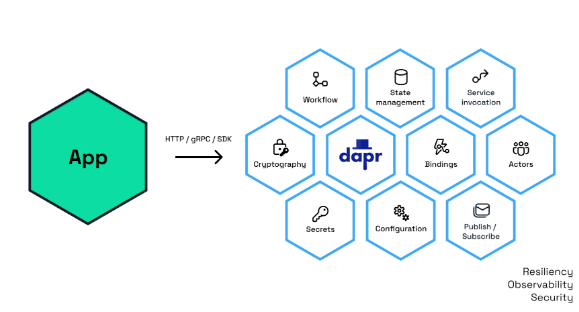
In the world of software development, microservices architecture stands out as the industry benchmark. This architectural style segments applications into distinct services, each deployable independently and organized around specific business capabilities. Such a design ensures flexibility, scalability, and resilience, with each service typically overseen by a specialized team. However, while this approach offers numerous benefits, it also introduces complexities. To navigate these challenges, developers turn to patterns, drawing parallels to time-tested design patterns from traditional software development, providing solutions for building robust distributed systems. For those seeking a comprehensive guide on these patterns, Chris Richardson’s microservices.io stands as a trusted repository, rich with insights and best practices from industry experts.
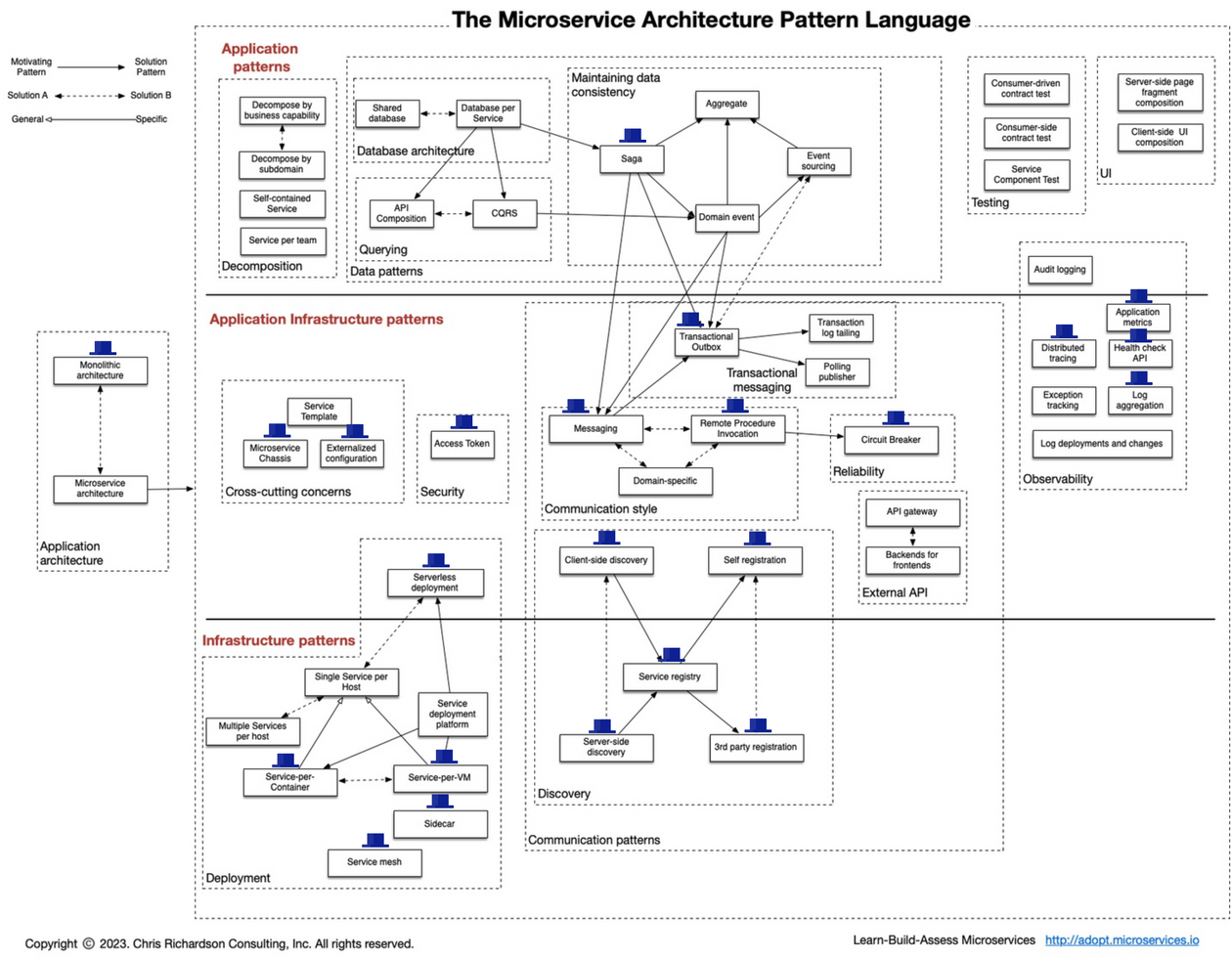 A pattern language for microservices by Chris Richardson, overlayed with matching Dapr capabilities
A pattern language for microservices by Chris Richardson, overlayed with matching Dapr capabilities
However, understanding patterns is just one part of the equation. Implementing them in real-world scenarios requires tools and frameworks. Positioned as a premier microservices chassis, Dapr is crafted for creating distributed applications that are secure, resilient, scalable, and observable. It doesn't merely align with the microservices patterns; it amplifies their potential, refining and simplifying their real-world implementation.
In the subsequent sections, I'll go through the patterns outlined in microservices.io, shedding light on how Dapr helps implement each. While numerous frameworks aim to address the cross-cutting concerns inherent in microservices, Dapr distinguishes itself. Its polyglot nature, sidecar operational mode, and non-restrictive stance on application architecture make it a unique and invaluable asset in the microservices toolkit.
Microservice Chassis
When embarking on the development of an application, developers often find themselves investing significant time in addressing cross-cutting concerns such as security, externalized configuration, logging, health checks, metrics, and distributed tracing. While these elements might seem straightforward, defining a curated set of dependencies that will be used in tens or hundreds of services can be a complex endeavor. The challenge amplifies when adopting a microservices architecture, given the multitude of services and the frequent creation of new ones. The Microservice Chassis pattern offers a solution by proposing the creation of a framework that serves as the foundation for microservices development. This chassis provides reusable build logic and mechanisms to handle these cross-cutting concerns, streamlining the development process.
As a polyglot framework, Dapr seamlessly handles cross-cutting concerns, allowing developers to focus on core functionalities without getting entangled in complexities. It provides built-in mechanisms for security, configuration management, logging, and more. With features like the Access Control capabilities for security, Configuration API for externalized settings, and health API endpoints for monitoring, Dapr ensures that these foundational concerns are seamlessly integrated, allowing developers to focus on core business logic without getting mired in the intricacies of these concerns. Unlike other frameworks, Dapr doesn't impose constraints on the application, granting developers the freedom to choose their preferred language, runtime, and programming style. In essence, Dapr transforms the theoretical benefits of the Microservice Chassis pattern into tangible results for real-world applications.
Sidecar
In microservices, there's often a need to augment services with additional capabilities without modifying the core service logic. The Sidecar pattern addresses this requirement. It involves deploying components of an application into separate processes or containers to provide a modular and scalable architecture. The main service runs in one container, and the sidecar service, which extends or enhances the main service, runs in a separate container but in the same network namespace. This ensures that the main service and the sidecar can communicate as if they are in the same process while being isolated from each other. The primary advantage of this pattern is the ability to separate concerns, modularize your application, and ensure that each component is focused on a specific responsibility.
Dapr is among the most popular implementations of the Sidecar pattern. When integrated into a microservices environment, Dapr runs as a sidecar alongside your service, providing a plethora of additional capabilities without requiring any changes to the main service. This includes features like state management, service-to-service invocation, pub/sub messaging, and more. By leveraging Dapr's sidecar architecture, developers can augment their services with powerful features, ensuring a robust, scalable, and feature-rich microservices ecosystem.
Service Mesh
As the number of services grows, managing inter-service communication, security, and observability becomes increasingly complex. A Service Mesh is a dedicated infrastructure layer built to handle service-to-service communication in a transparent and technology-agnostic manner. It provides features like load balancing, service discovery, observability, and security without requiring changes to the application code. By offloading these concerns to the Service Mesh, developers can focus on building business logic, while the mesh ensures that services can securely and efficiently communicate with each other.
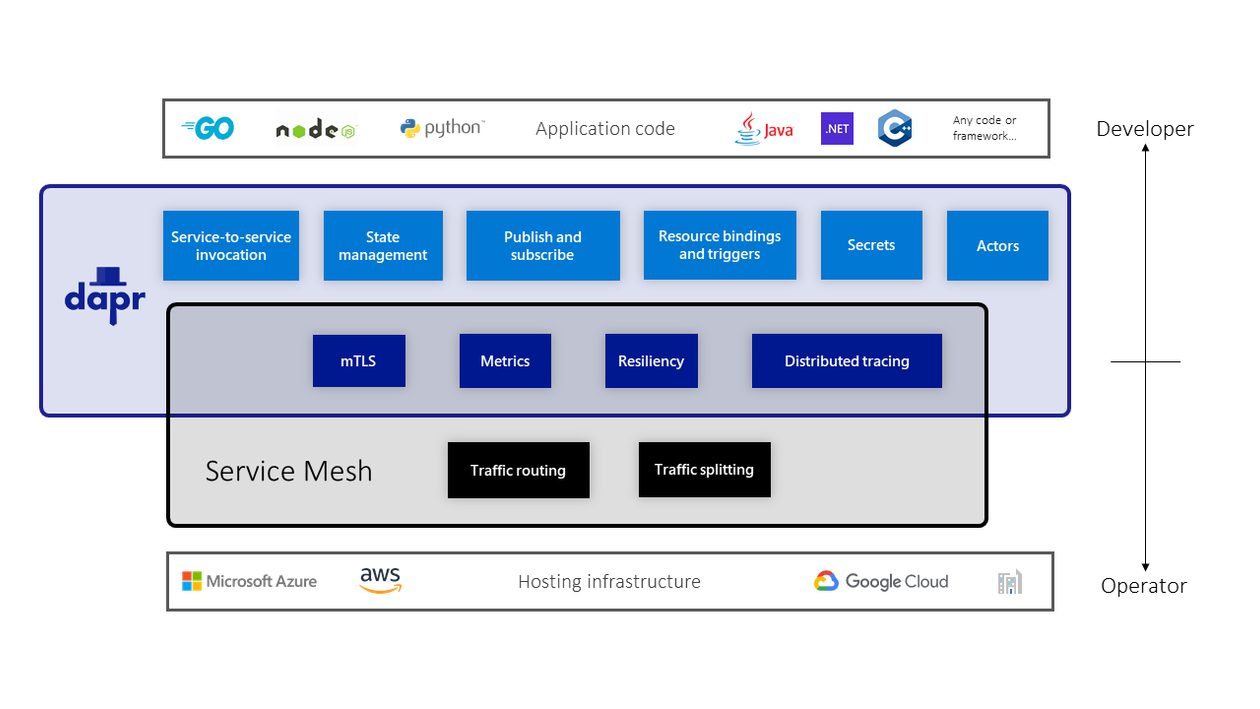 How Dapr and service meshes compare
How Dapr and service meshes compare
Dapr operates as a lightweight service mesh, providing a network layer that facilitates service discovery and ensures secure service-to-service interactions. While there are overlapping capabilities between Dapr and traditional service meshes, Dapr distinguishes itself by being developer-centric, focusing on building blocks that simplify microservices development. Unlike service meshes which are primarily infrastructure-centric and deal with network concepts like IP and DNS addresses, Dapr offers service discovery and invocation via names, a more developer-friendly approach. Beyond the common features like mTLS encryption, metric collection, and distributed tracing, Dapr introduces application-level building blocks for state management, pub/sub messaging, actors, and more. This ensures that developers gain a comprehensive toolset, not just for networking, but for holistic microservices development.
Saga
In the world of microservices, ensuring data consistency across services can be a challenge, especially when each service has its own database. The Saga pattern provides a solution to this challenge. Instead of relying on traditional distributed transactions, the Saga pattern breaks the transaction into a series of local transactions, each executed within its own service and database. These local transactions are coordinated in a specific sequence to ensure overall data consistency. If one local transaction fails, compensating transactions are executed to revert the changes made by the previous transactions. This approach offers a way to maintain data consistency without the need for distributed transactions, which are often not feasible in microservices architectures.
 Dapr workflow overview
Dapr workflow overview
Dapr offers a concrete solution to implement the Saga pattern through its Workflow API. This API allows developers to sequence local transactions, or implement other stateful workflow patterns ensuring that data remains consistent across services. Dapr Workflow API serves as a foundational tool in this regard, streamlining the process and ensuring reliability.
Transactional Outbox
In microservices architectures, a common challenge arises when a service command needs to update aggregates in the database and simultaneously send messages or events to a message broker. The goal is to ensure atomicity - if the database transaction commits, the messages must be sent; if the database rolls back, the messages must not be sent. Traditional distributed transactions (2PC) are often not feasible or desirable due to various constraints. The Transactional Outbox pattern addresses this issue. It suggests that the service stores the message in the database as part of the transaction that updates the business entities. A separate process then retrieves and sends these messages to the message broker. This ensures that messages are sent only if the database transaction commits, preserving data consistency and order of operations.
Dapr provides a robust solution to this challenge with its Outbox feature in StateStore API. This feature allows for atomic updates to the database while also sending messages to the designated broker. By utilizing the StateStore API, developers can seamlessly integrate the Transactional Outbox pattern into their microservices, ensuring data consistency and reliable message delivery across large number of databases and message brokers.
Messaging
In the realm of microservices, reliable asynchronous communication between services is paramount. Instead of services communicating directly with synchronous calls, they exchange messages via message channels. This asynchronous mode of communication decouples services, allowing them to operate independently. It ensures that even if one service is slow or unavailable, others can continue their operations without being directly affected. This approach enhances the system's resilience, scalability, and flexibility.
Dapr's PubSub API is tailored to harness the power of asynchronous messaging for inter-service communication. By leveraging this API, developers can easily implement messaging patterns in their microservices architecture. The PubSub API ensures reliable message delivery, supports multiple messaging brokers, and abstracts the complexities of direct broker interactions.
Request/Reply Interaction
Remote Procedure Invocation (RPI) is a communication style that enables services in a microservices architecture to communicate with each other by invoking methods in a remote service. The primary advantage of RPI is its straightforwardness, allowing for direct, point-to-point communication between services. However, it's essential to manage the associated challenges, such as service discovery, reliability, encryption, to ensure the system remains resilient and secure.
Dapr addresses the challenges with its Service Invocation API. This API provides an RPI-based protocol tailored for inter-service communication in a microservices setup. By abstracting the underlying complexities, Dapr ensures that services can communicate synchronously without getting entangled in the intricacies of direct service-to-service calls. Moreover, Dapr's Service Invocation API offers built-in features like retries, error handling, and traffic control, ensuring that communications are both reliable and secure.
Circuit Breaker
In a microservices architecture, services often collaborate to handle requests. However, when one service synchronously invokes another, there's a risk that the called service might be unavailable or might exhibit high latency, rendering it essentially unusable. Such scenarios can lead to resource exhaustion in the calling service, making it unable to handle other requests. This can further cascade the failure to other services throughout the application. The Circuit Breaker pattern addresses this challenge. It functions similarly to an electrical circuit breaker. When consecutive failures cross a certain threshold, the circuit breaker "trips." For a set timeout period, all attempts to invoke the problematic service fail immediately. After this period, the circuit breaker allows a few test requests. If these succeed, normal operation resumes; if not, the timeout period restarts.
Dapr offers a concrete solution to this challenge with its Resiliency policy. This policy ensures that when the failure rate of a call exceeds a certain threshold, the call fails immediately, preventing resource exhaustion and potential cascading failures. By leveraging Dapr's resiliency policy, developers can implement the Circuit Breaker pattern efficiently, ensuring that their microservices architecture remains robust and resilient against unexpected service failures or latencies.
Access Token
In the intricate landscape of microservices, ensuring secure communication and access between services is paramount. The Access Token pattern involves issuing tokens to clients, granting them limited access to a service. These tokens encapsulate the information required to determine whether a client is authorized to perform a given operation. The primary advantage of using access tokens is that they provide a way to ensure that only authenticated and authorized clients can access services or specific operations within those services.
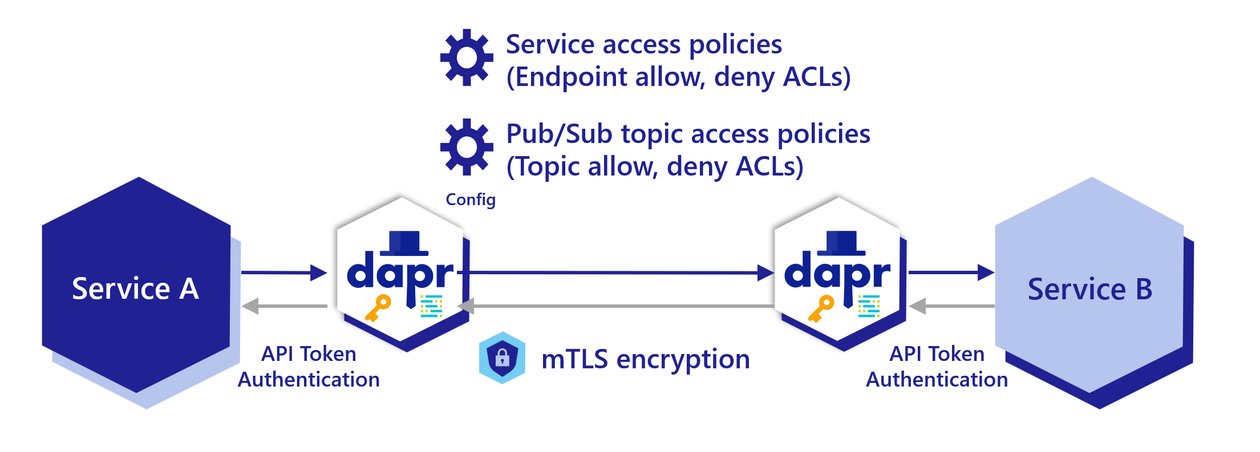 Dapr secure communications architecture
Dapr secure communications architecture
Dapr provides a robust mechanism to implement this pattern through its Access Control capabilities based on SPIFFE Ids. With Dapr's Access Control, developers can define and enforce policies that restrict what operations calling applications can perform on the called app. This ensures a fine-grained control over service interactions, making the system more secure and resilient against potential threats.
Service Instance per Container
The Service Instance per Container pattern deployment strategy, places each service instance in its own container. Containers, being lightweight and isolated, provide an environment where the service can run with its dependencies, ensuring consistency across different stages of deployment. This approach offers several benefits: it ensures isolation, making each service instance independent of others; it provides scalability, as new instances can be spun up quickly; and it enhances portability, as each service containts its built-time dependencies.
Dapr aligns perfectly with this deployment model as it is designed to operate best in containerized environments. When a service is deployed with Dapr, a Dapr sidecar container runs alongside the service container, enhancing its capabilities without intruding into the service's operations. Dapr's deployment model, ensures that each service instance, along with its Dapr sidecar, remains isolated in its container, benefiting from the inherent advantages of the Service Instance per Container pattern such as scalable, and resilient microservices deployments.
Service Instance per VM
In certain deployment scenarios, especially when dealing with large-scale applications or when containers might not be the optimal choice, deploying each service instance on its own Virtual Machine (VM) becomes a viable strategy. The Service Instance per VM pattern emphasizes this approach. By allocating a dedicated VM for each service instance, you ensure that the service has a dedicated set of resources, leading to predictable performance. This isolation also means that failures or resource contention in one service won't directly impact others. Moreover, VMs provide a higher degree of isolation compared to containers, which can be crucial for certain security or compliance requirements.
Dapr is versatile and can be seamlessly deployed in a VM-based environment. Whether you're deploying Dapr on its own dedicated VM or using Dapr Ambient to share its capabilities among multiple Pods, Dapr ensures that microservices can communicate and operate efficiently. This flexibility means that developers aren't confined to containerized environments and can leverage Dapr's capabilities in VM-based deployments, ensuring that the benefits of Dapr, such as state management, service invocation, and pub/sub messaging, are available regardless of the deployment strategy. Dapr's deployment documentation provides insights into how it can be integrated into various environments, including VMs, or the real edge.
Service Discovery
In microservices architectures, the dynamic nature of service instances and their locations, especially in containerized environments, presents a challenge: how does a client of a service discover the location of a service instance? Two prevalent patterns address this challenge: Client-side Discovery and Server-side Discovery. The former involves clients querying a Service Registry to discover the current locations of service instances, ensuring they always communicate with available and healthy instances. On the other hand, the Server-side Discovery pattern simplifies client code by routing requests via a knowledgeable router, often a load balancer, which interacts with the service registry.
Dapr's sidecar architecture adeptly addresses both these patterns. While the sidecar operates alongside a service, akin to a client, it isn't embedded within the application. This unique positioning allows it to query a service registry, discovering other service instances' locations, and also act as a router for inter-service calls. By offloading the intricacies of service discovery to the Dapr Service Invocation API, developers can ensure reliable service-to-service communication, even in environments where service locations change dynamically.
Service Registry
In dynamic microservices environments, the locations and number of service instances can frequently change. This poses a challenge: how can clients or routers be aware of the current available instances of a service? The Service Registry pattern offers a solution. It proposes a centralized registry where service instances register themselves upon startup and deregister upon shutdown. This registry acts as a database of services, their instances, and their locations. Clients or routers can then query this registry to discover the current locations of service instances.
Dapr offers a seamless integration with the Service Registry concept, providing a unified interface to various service registry implementations. Dapr's pluggable name resolution components used in Service Invocation API cater to diverse hosting platforms, from Kubernetes, which utilizes its DNS service, to self-hosted machines using mDNS or even HashiCorp's Consul in varied environments.
Self Registration
The Self Registration pattern ensures that services can discover each other in inter-service communication. When a service instance starts up, instead of relying on an external agent or system to register it with a service registry, the service instance itself takes the responsibility of registering. This ensures that the service registry always has the most up-to-date information about available service instances. By automating the registration process, the Self Registration pattern reduces manual intervention, potential errors, and ensures that the service registry is always current.
When a service with a Dapr sidecar is deployed, the Dapr sidecar takes the initiative to register itself with the service registry. This automated process ensures that the service is immediately discoverable by other services in the ecosystem. This not only simplifies the deployment process but also enhances the reliability and efficiency of service-to-service communication in architectures built with Dapr.
3rd Party Registration
In some microservices architectures, not all services or endpoints are created or managed by the same team or entity. There might be third-party services or endpoints that need to be integrated into the system. These third-party services might not follow the same registration patterns as internal services. With the 3rd Party Registration pattern, instead of the service registering itself (as in Self Registration), an external agent or system is responsible for registering the service with the service registry. This ensures that third-party services, which might not have the capability or permission to register themselves, are still discoverable and can be integrated seamlessly into the system.
Dapr offers flexibility in this regard too. Even non-Dapr 3rd party endpoints can be registered within the Dapr runtime, ensuring they benefit from service discovery, resiliency, and observability features that Dapr provides. This means that developers can integrate third-party services into their Dapr-enabled microservices architecture without those services being Dapr-aware. This allows a more cohesive and resilient microservices ecosystem, irrespective of the origin of the services.
Externalized Configuration
In the world of microservices, applications often interact with various infrastructure and third-party services. Examples include service registries, message brokers, databases, payment processors, and more. A significant challenge arises when trying to ensure that a service can run across multiple environments (like dev, test, staging, production) without any modifications. The Externalized Configuration pattern recommends externalizing all application configurations. This ensures that the service remains environment-agnostic and can adapt to different setups without any code changes.
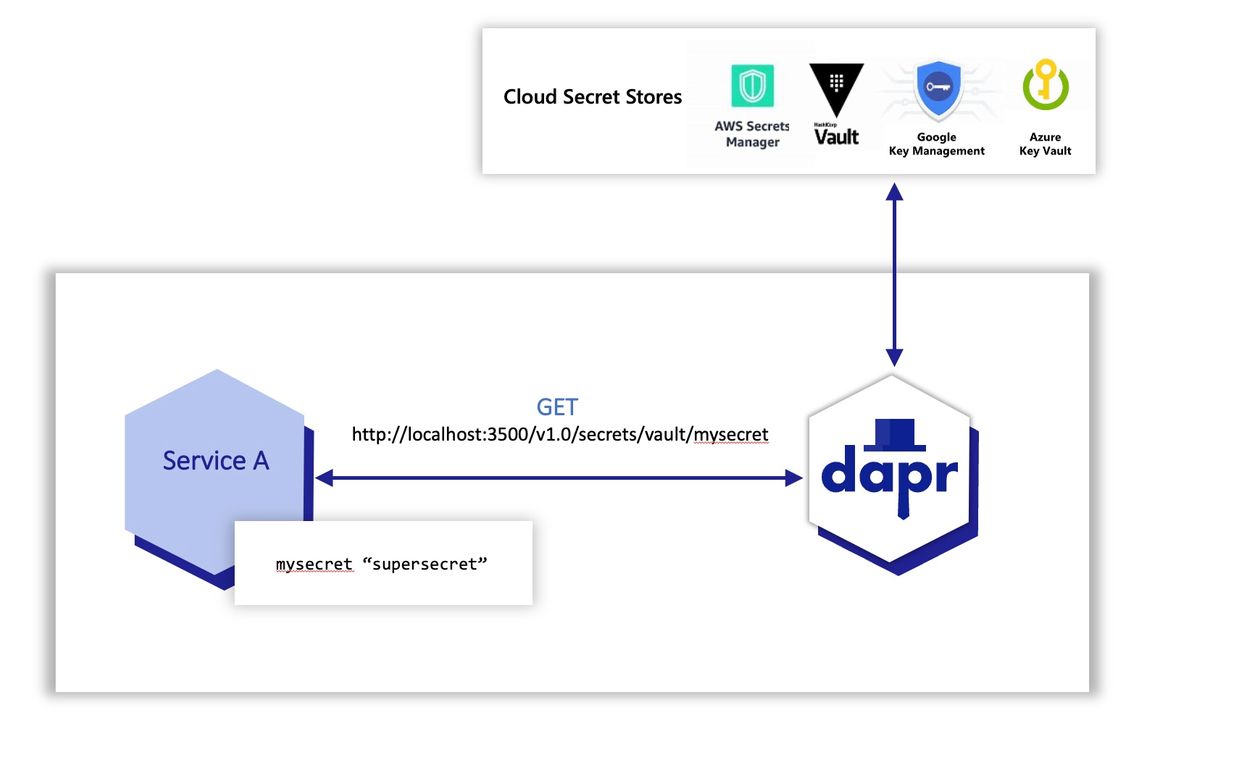 Dapr secrets stores overview
Dapr secrets stores overview
Dapr provides a robust solution to this challenge with its Secrets and Configuration APIs. These APIs allow developers to externalize configurations, including sensitive information like database credentials. Instead of hardcoding configurations or placing them in easily accessible files, Dapr ensures that they are securely stored and can be fetched dynamically when needed.
Health Check API
In a microservices architecture, ensuring the health, availability, and self-healing of service instances is paramount. The Health Check API pattern proposes that each service should expose an API endpoint (e.g., HTTP /health) that indicates the health status of the service. This endpoint performs various checks, such as the status of connections to infrastructure services, the health of the host (e.g., disk space), and any application-specific logic. By periodically querying this endpoint, monitoring systems, service registries, or load balancers can determine the health of a service instance. This ensures that alerts are generated for unhealthy instances, and requests are only routed to healthy service instances, enhancing the reliability and efficiency of the system.
Dapr elevates the health check pattern by conducting periodic health checks on your service, ensuring its optimal functioning. Once app health checks are enabled, the Dapr sidecar routinely polls the application. If a health issue is detected, Dapr takes proactive measures: it unsubscribes from all pub/sub subscriptions, halts all input bindings, and short-circuits service-invocation requests, ensuring they aren't forwarded to the application. This comprehensive approach ensures that any potential issues are swiftly identified and mitigated, fostering a robust and resilient system.
Distributed Tracing
In complex microservices architectures, understanding the flow of requests across multiple services can be challenging. The Distributed Tracing pattern involves instrumenting services with code that assigns each external request a unique identifier. This identifier is then passed to all services involved in handling the request. By doing so, it becomes possible to trace the journey of a request across various services, recording information such as start time, end time, and other relevant metrics providing invaluable insights into the behavior of the system.
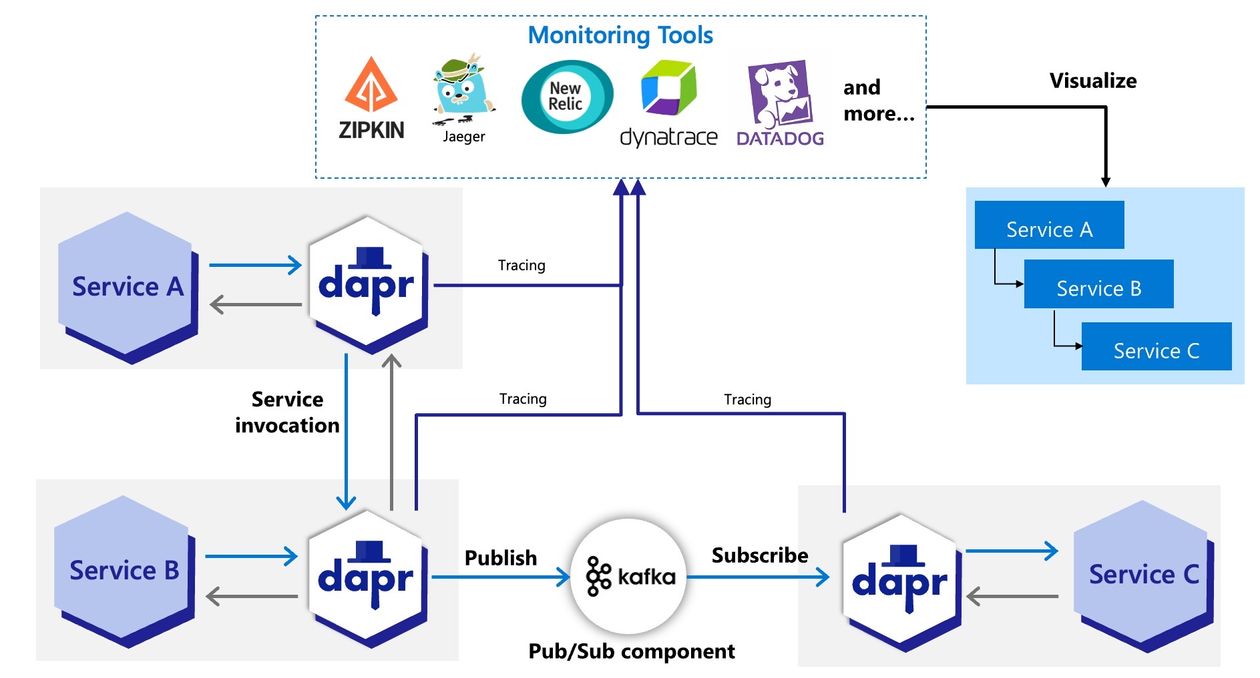 Dapr distributed tracing overview
Dapr distributed tracing overview
Dapr automatically takes care of creating trace headers and ensures they are captured and forwarded appropriately. With Dapr’s observability capabilities, developers don't need to manually instrument their code for tracing; Dapr handles it seamlessly. Moreover, Dapr integrates with popular tracing systems, ensuring that the traces can be visualized and analyzed in a centralized manner.
Application Metrics
Application Metrics are a set of quantitative data points that provide insights into the performance, behavior, and health of an application or service. By collecting and analyzing these metrics, developers and operations teams can identify bottlenecks, detect anomalies, and optimize the performance of their services, enabling proactive monitoring and ensuring optimal system health.
Dapr automatically gathers a wide range of networking metrics, capturing data related to request rates, error rates, and latency, among others. Dapr ensures that these metrics are delivered to a centralized metrics service, allowing for comprehensive monitoring and analysis. This means that developers and operations teams can have a unified view of the system's performance, irrespective of the number of services or their complexity.
Serverless Deployment
In the evolving landscape of software development, the need for scalable, and cost-effective deployment solutions is growing. Serverless Deployment refers to a deployment infrastructure that abstracts away any concept of servers, be it physical, virtual hosts, or containers. The primary advantage is that developers can focus solely on their code, without concerning themselves with the underlying infrastructure. The serverless platform automatically scales services based on the load, ensuring optimal resource utilization.
Dapr is gearing up for the serverless era too. Soon, developers will be able to access Dapr's rich capabilities as serverless APIs. This means that the vast array of features Dapr offers, from state management to messaging, will be available in a serverless context, ensuring developers get the best of both worlds. By integrating Dapr into serverless environments, developers can ensure more robust, scalable, and feature-rich applications without the complexities of managing the Dapr infrastructure. For the updates on this pattern, follow @diagridio on Twitter and you can be among the first to try it out.
Summary
Patterns play a pivotal role in software development, serving as a shared language to communicate common challenges and best practices. They encapsulate proven solutions to recurring problems, ensuring that developers don't have to reinvent the wheel with each new project. However, while patterns provide a conceptual blueprint, they remain abstract ideas. Historically, the challenges of building reliable applications and the implementations of these patterns were addressed using application servers, service buses, and microservices frameworks like Spring Cloud, among other language-specific solutions. But to truly bring these patterns to life in the modern era, we need cloud-native frameworks and chassis like Dapr. Dapr tackles these common engineering challenges by presenting patterns as polyglot APIs, aligning with the cloud-native philosophy and offering benefits to the whole organization. This ensures that developers can leverage best practices across multiple languages and platforms, streamlining the development process and enhancing application resilience and scalability.



